Acer R7 Review: Something Different
by Jarred Walton on August 15, 2013 12:45 AM ESTI’m going to stuff all of the benchmarks onto one page for this review; there’s really nothing noteworthy about the performance of the R7, at least on the CPU and graphics side of things. Battery life and display quality are a bit more important, but given the timeliness of this review (or the lack thereof), most of what we wanted to say was covered on the previous pages. So, here are the benchmarks, using our updated 2013 mobility suite. I’ll save a bit of short commentary for after the break.
First, here’s a quick overview of the laptops we’re including in our graphs. With the update to our 2013 mobile test suite, we’re somewhat at the mercy of our results database. Most of our comparisons that are meaningful are going to be with Ultrabooks, and given that were dealing with basically Ultrabook hardware the Acer R7 posts similar performance. We tossed in the MSI GX60 Richland APU notebook as a comparison, not because the notebooks are similar but because the A10-5750 APU more or less competes with Ivy Bridge ULV processors. Note that we did not run every benchmark on every laptop, so some charts might be missing certain laptops.
| Specifications of Benchmarked Laptops | ||||||
| Laptop | CPU | GPU | Storage | RAM | LCD | Battery |
| Acer R7-571-6858 | Intel Core i5-3317U | HD 4000 | 500GB HDD + 24GB SSD | 1x4GB + 1x2GB | 15.6” 1080p Glossy AHVA Touchscreen | 4-cell 54Wh |
| Acer S7-391-9886 | Intel Core i7-3517U | HD 4000 | 2x128GB RAID 0 SSDs | 2x2GB | 13.3” 1080p Glossy IPS Touchscreen | 4-cell 35Wh |
| Acer S7-392-9890 (Preview) | Intel Core i7-4500U | HD 4400 | 2x128GB RAID 0 SSDs | 2x4GB | 13.3” 1080p Glossy IPS Touchscreen | 4-cell 46Wh |
| AMD Kabini | AMD A4-5000M | HD 8330 | 256GB SSD | 1x4GB | 14” 1080p Matte IPS | 4-cell 45Wh |
| Apple MacBook Air 13 (2013) | Intel Core i5-4250U | HD 5000 | 128GB SSD | 2x2GB | 13.3” 1440x900 Glossy TN | 4-cell 54Wh |
| Clevo W550EU (Mythlogic) | Intel Core i5-3340M | HD 4000 | 256GB SSD | 2x4GB | 15.6” 1080p Matte IPS | 6-cell 62-Wh |
| HP Spectre XT TouchSmart | Intel core i7-3517U | HD 4000 | 500GB HDD + 32GB SSD | 2x4GB | 15.6” 1080p Glossy IPS Touchscreen | 4-cell 48Wh |
| Lenovo ThinkPad X1 Carbon | Intel Core i5-3427U | HD 4000 | 180GB SSD | 2x2GB | 14” 1600x900 Glossy TN Touchscreen | 4-cell 45Wh |
| MSI GE40 | Intel Core i7-4702MQ | HD 4600 / GTX 760M | 128GB SSD + 750GB HDD | 1x8GB | 14” 1600x900 Matte TN | 6-cell 65Wh |
| MSI GX60 | AMD A10-5750 | HD 8650G | 750GB HDD | 1x8GB | 15.6” 1080p Matte TN | 9-cell 87Wh |
| Toshiba KIRAbook | Intel Core i7-3537U | HD 4000 | 256GB SSD | 2x4GB | 13.3” 2560x1440 Glossy IPS Touchscreen | 4-cell 52Wh |
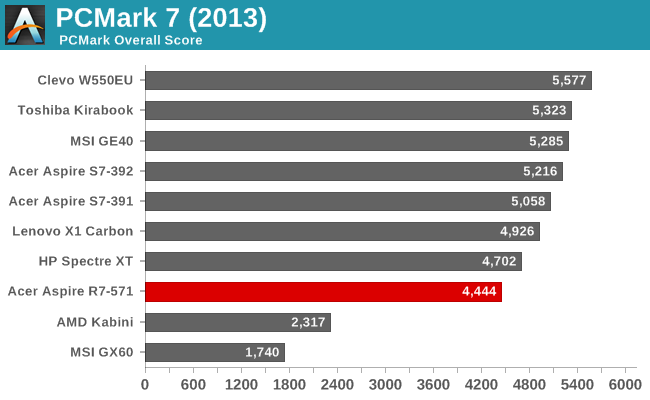
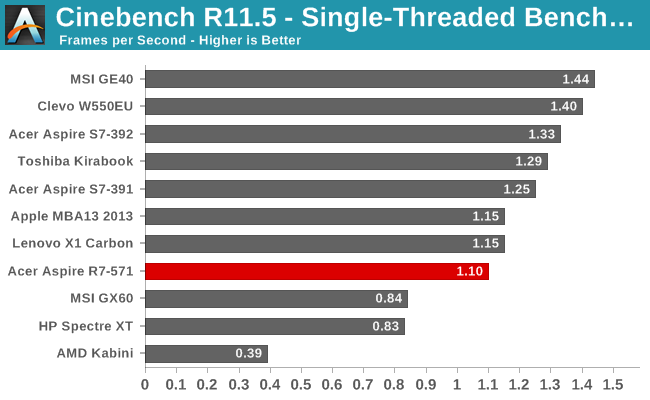
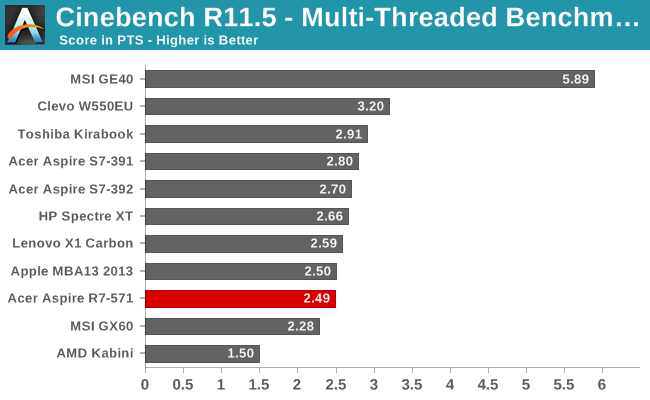
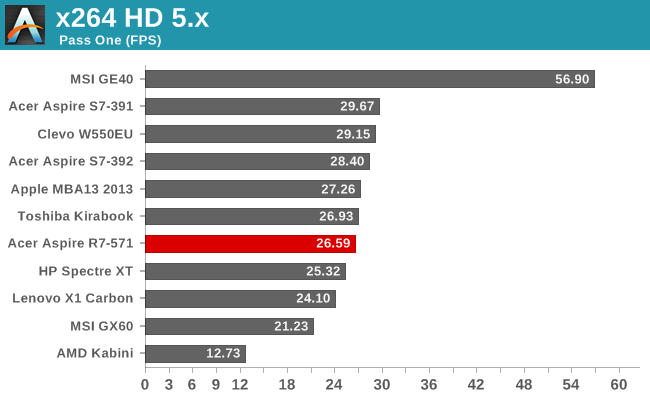
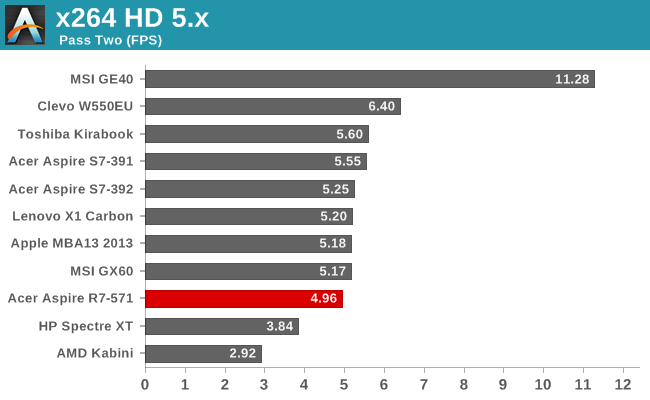
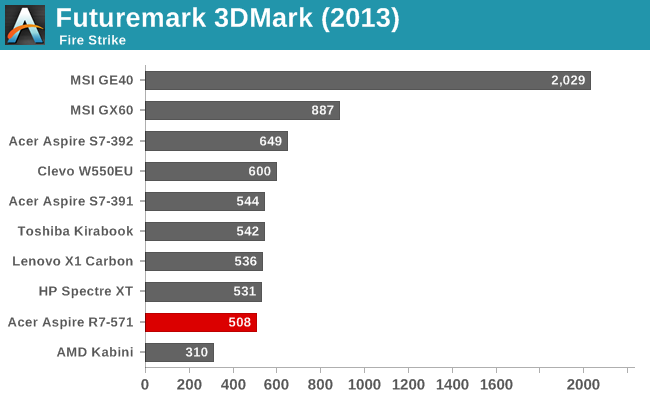


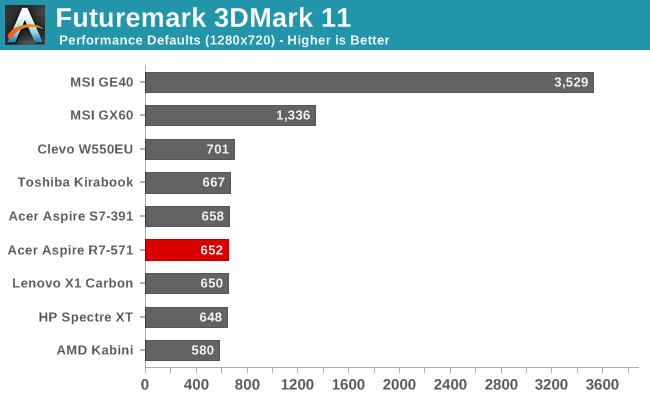
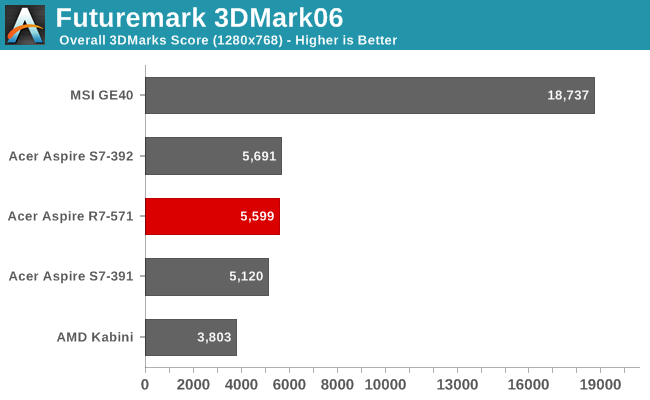

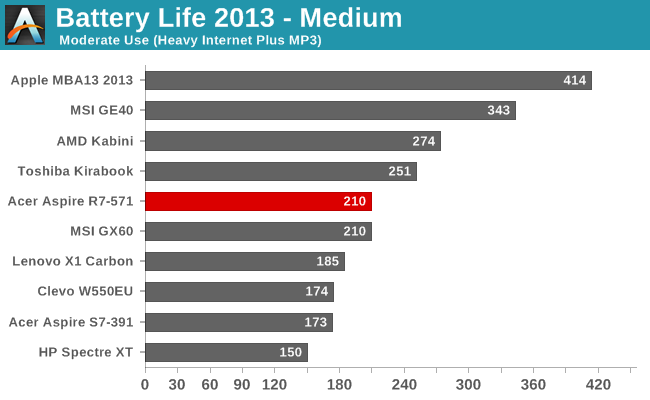
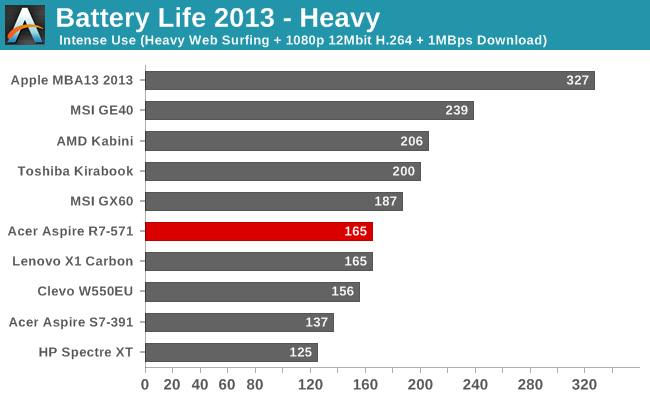
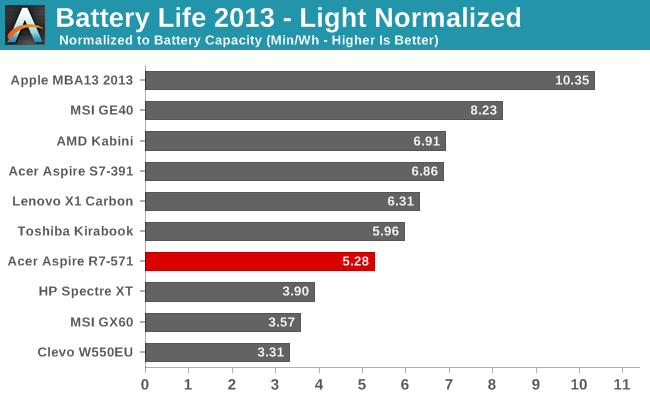
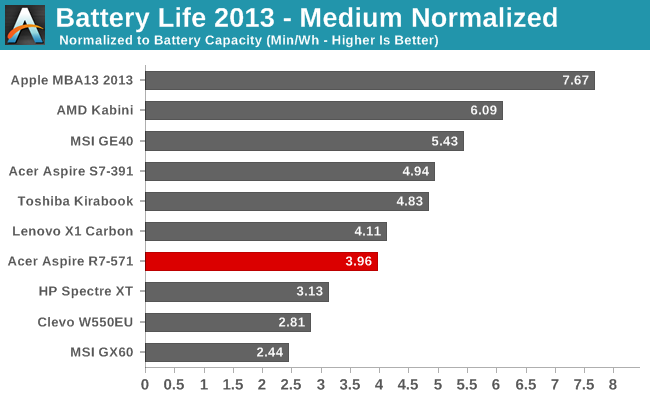
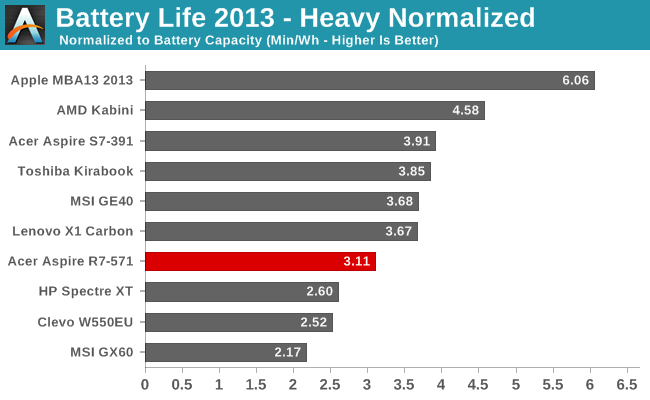
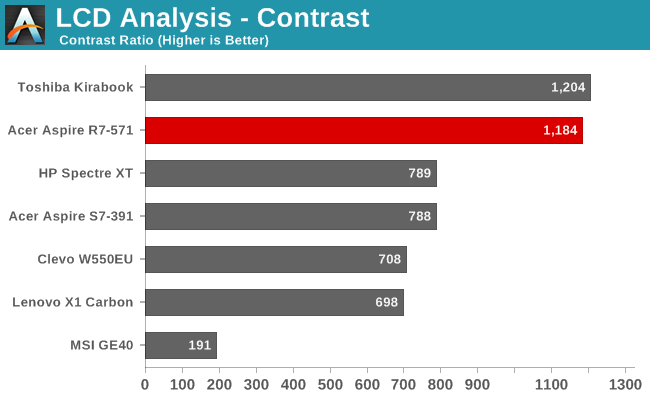

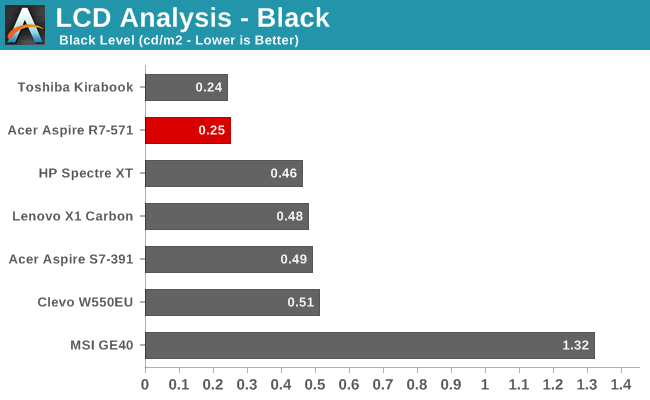
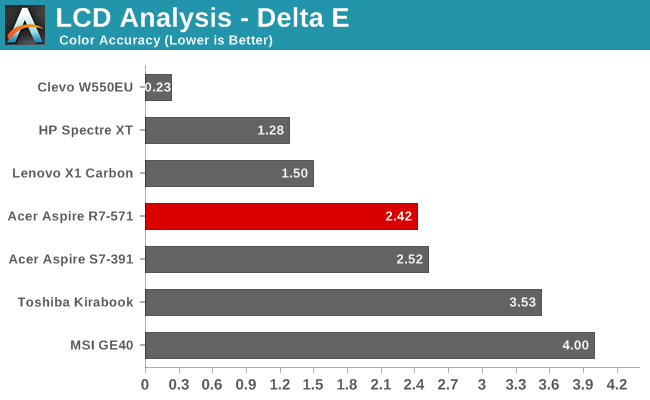
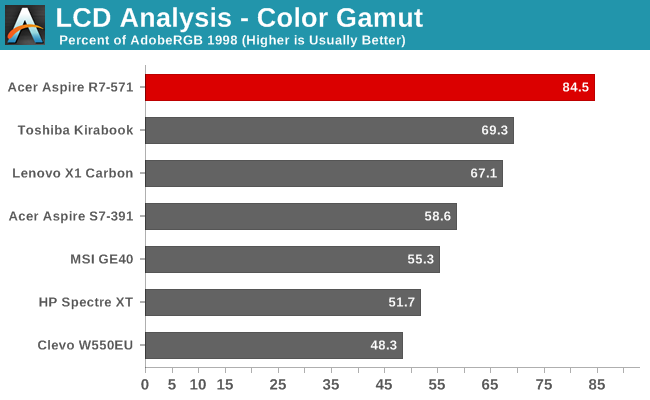
Whew! That’s a lot of benchmarks, and there are even more results in Mobile Bench – like if you really want to know how the R7 handles our gaming suite, for example, it’s there! If you don’t want to look but want a short summary, only one game gets above 10FPS at the Enthusiast settings, and just barely; with Mainstream most of the games fall in the 10-20FPS range, so basically unplayable. Even our Value gaming settings are mostly too much for the HD 4000, though most of the Windows 8 games in the Store are far less demanding and will run just fine – no surprise given most of those are targeting Windows RT, which means GPUs that are often less than half as fast as the HD 4000.
Elsewhere, CPU performance is about where you’d expect it: lower than Core i7 ULV/ULT, and similar to other Core i5 ULV parts. The hybrid storage solution means that PCMark7 doesn’t score quite as well as pure SSDs, but it’s still a huge step up from what you’d get from a pure HDD setup (e.g. GX60). Since I just mentioned the GX60, it’s also interesting to note that Core i5 ULV generally posts better CPU performance than AMD’s Richland APUs – though the second pass of x264 HD at least put AMD slightly ahead. GPU performance is nothing to write home about; it’s more than sufficient for running most Windows tasks, but anything graphically intensive is best off served by a dedicated GPU (or at the very least Intel’s Iris HD Graphics Iris Pro).
Battery life isn’t particularly stellar, but we’ve also seen worse – sometimes much worse. Realistically, four hours of light use is possible off a single charge, while heavier workloads will bring you closer to 2.5 hours. That puts the R7 slightly ahead of the Lenovo X1 Carbon in most tests, but only thanks to its higher battery capacity. In terms of normalized battery life, the R7 places fourth from last of the tested notebooks, and given that Clevo typically doesn’t optimized very well for power use and the MSI GX60 is classified as a gaming notebook, only the win over the HP Spectre XT TouchSmart is really worth mentioning. When we start to look at Haswell-based notebooks, even though Ivy Bridge was pretty good it looks pretty poor in light of what’s now available. Apple’s MacBook Air 13 runs at different OS, but the MSI GE40 has a quad-core Haswell CPU and a slightly larger battery, with about 50% more battery life than the Acer R7.
Wrapping up the benchmarks, as I mentioned before, the one standout item in the R7 is the display. Contrast is excellent, and color quality is at least decent – the 85% color gamut is actually a bit overblown, however, as some of the colors are actually outside of the Adobe RGB 1998 color space while others fall far short (green in particular is lacking). Still, the great viewing angles offered by AHVA combined with good overall performance definitely deserve commendation.










113 Comments
View All Comments
JarredWalton - Thursday, August 15, 2013 - link
At the bottom of all the charts: "Whew! That’s a lot of benchmarks, and there are even more results in Mobile Bench – like if you really want to know how the R7 handles our gaming suite, for example, it’s there!" Here's the direct link: http://www.anandtech.com/bench/product/979ddriver - Saturday, August 17, 2013 - link
Providing results on the side is not the same as including them in a direct comparison. I guess it just real gaming results didn't look as good as synthetic benches, and who on anand would want to make intel's top notch struggle with amd's puny parts... Surely, you can make the comparison for yourself using the charts, but the in-article charts are going to influence much more people. So why don't we make them better, or is it just a coincidence the included synthetic graphics results are in absolute contradiction to real world graphics? By doing such "selections", the article presents a graphically superior part which it isn't, which is technically bending the truth.JarredWalton - Saturday, August 17, 2013 - link
Please. How about "this can't run games, I said as much, and why show graphs that merely reinforce the fact?" It's not like we haven't shown HD 4000 gaming performance before; no use beating a dead horse. Except, funny how HD 4000 isn't all that much slower than AMD's latest when you get right down to it. Both are "too slow" for many games. Hopefully Kaveri can fix that, but if the CPU is still a bottleneck it will only run some games well and others will struggle, just like with Trinity/Richland.cjb110 - Thursday, August 15, 2013 - link
The problem with the current Windows 8 apps is I can't see many creation apps, they're all browsing, or light 'mobile'-esq usage...none of them are like traditional desktop apps. Even the media players are all basic barebones, little or no media management.Until someone, preferably MS shows that the Metro UI can also do complicated creation type apps, Windows 8 will always live in this weird schizo realm of sometimes mobile sometimes decades old desktop (with all the issues that MS's desktop apps have)
ZeDestructor - Thursday, August 15, 2013 - link
That's because they didn't. Here's the data and rationale behind all they did, and when you get down to it, it makes a lot of sense.https://blogs.msdn.com/b/b8/archive/2011/10/03/evo...
https://blogs.msdn.com/b/b8/archive/2011/10/04/des...
I originally disliked the start screen, but then I found out all my use cases were nicely covered and I stopped caring. I did kinda miss the start button though...
Well, that and the fact that they won't let me change program icons... grr...
ZeDestructor - Thursday, August 15, 2013 - link
And some more hard data and rationale:https://blogs.msdn.com/b/b8/archive/2011/10/18/des...
https://blogs.msdn.com/b/b8/archive/2011/10/11/ref...
snajk138 - Thursday, August 15, 2013 - link
Try OblyTile: http://forum.xda-developers.com/showthread.php?t=1...ZeDestructor - Thursday, August 15, 2013 - link
But effort..... besides, I'm fine with it now.. its just more pactical :Drootheday - Thursday, August 15, 2013 - link
the key usage model I see for the ezel hinge is commercial air travel. You have the laptop on the tray but the seat in front of you is too close to let a normal laptop screen hinge tip far enough for good viewing (especially in economy, especially if the person in front reclines their seat) unless you slide the laptop so close to you that your elbows are sticking into the person on your right/left or out in the aisle.So you use the ezel hinge to raise the screen above the keyboard and forward and tipped way back (somewhere between "shifted forward" mode and "floating table" mode. Now you have a straight on view of the screen and your hands are below the screen on the keyboard. the keyboard itself is far enough in front of you that it isn't awkward to type.
For people who travel a lot and need to type on a real keyboard with a decent sized screen, this form factor makes sense to me.
jaydee - Thursday, August 15, 2013 - link
In the photo gallery, it really looks like a mini-DP port, not a mini-VGA on the left side next to the HDMI port, could you please confirm?